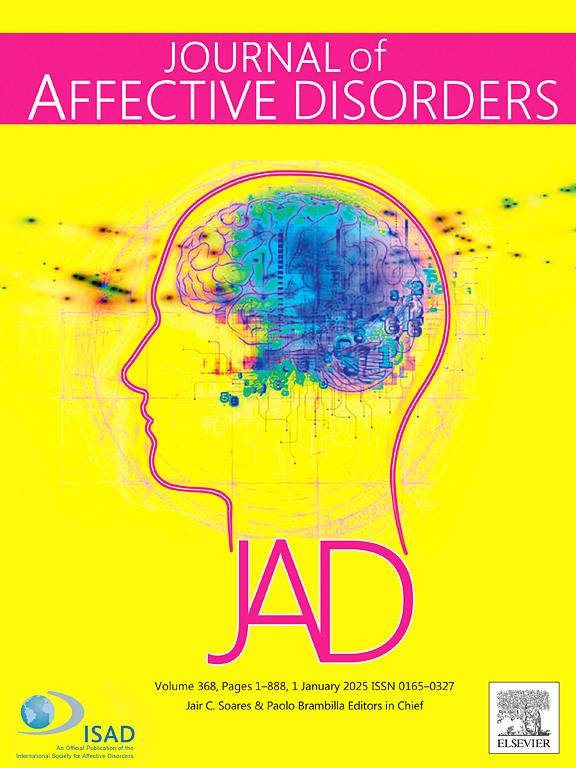产后抑郁相关生物心理社会因素的综合网络分析
IF 4.9
2区 医学
Q1 CLINICAL NEUROLOGY
引用次数: 0
摘要
本研究调查了一系列产后抑郁症(PPD)危险因素和保护因素之间的关系,以及它们与产后抑郁症症状的中心性和独特关系。方法对妊娠风险评估监测系统第7期(2012-2015年)采集的横断面数据进行混合图形网络模型估计。研究人员在女性出生后两到六个月联系她们。57,518名妇女中的一半被纳入探索性模型1,另一半被纳入模型2进行交叉验证。对广泛选择的生物心理社会因素进行了建模,包括社会人口变量、孕产妇健康(行为)指数、妊娠过程、支持、婴儿变量和压力源。结果获得了一个紧密相连的风险因素和保护因素网络。妊娠持续时间、婴儿重症监护病房位置、不孕症治疗、出生体重、收入和分娩类别是模型中最重要的变量。在模型中包含的35个生物心理社会因素中,11个与PPD在两个样本中都有很强的相关性。高收入、孕前体育锻炼、怀孕意向和关注抑郁风险的产前护理与抑郁严重程度降低有关。其他几个变量,包括抑郁症病史、孕前节食、产前危险行为和个人压力源,都与抑郁症严重程度的增加有独特的关系。产后抑郁症状随着时间的增加而减少。出现抑郁症状的妇女更有可能依赖产后保健工作者的援助。模型1和模型2的结果基本相同。结论:尽管这些发现是横断面的,但它们揭示了PPD关键风险因素和保护因素之间的复杂联系,对早期发现和预防具有重要意义。本文章由计算机程序翻译,如有差异,请以英文原文为准。
A comprehensive network analysis of biopsychosocial factors associated with postpartum depression
Background
This study investigated relations between a broad set of postpartum depression (PPD) risk- and protective factors, their centrality and unique relations with PPD symptoms.
Methods
Mixed graphical network models were estimated in cross-sectional data collected during Phase 7 (2012–2015) of the Pregnancy Risk Assessment Monitoring System. Women were contacted two to six months following birth. Half of the 57,518 women were included in exploratory model 1, the other half in model 2 for cross-validation. A broad selection of biopsychosocial factors were modelled, including sociodemographic variables, indices of maternal health (behavior), pregnancy course, support, infant variables, and stressors.
Results
A densely connected network of risk- and protective factors was obtained. Pregnancy duration, infant intensive care unit placement, infertility treatment, birth weight, income, and childbirth classes were ranked among the most central variables in the model. Out of 35 biopsychosocial factors included in the model, 11 were robustly related with PPD across both samples. High income, pre-pregnancy physical activity, pregnancy intention, and prenatal care focusing on depression risk were related to lower depression severity. Several other variables, including prior history of depression, pre-pregnancy dieting, prenatal risk behavior, and personal stressors were uniquely related to increased depression severity. Depressive complaints reduced with increased time since delivery. Women experiencing depressive symptoms were more likely to rely on aid from health workers postpartum. Results from models 1 and 2 were largely identical.
Conclusions
Although cross-sectional in nature, these findings shed light on the complex associations between key risk- and protective factors for PPD, with implications for early detection and prevention.
求助全文
通过发布文献求助,成功后即可免费获取论文全文。
去求助
来源期刊

Journal of affective disorders
医学-精神病学
CiteScore
10.90
自引率
6.10%
发文量
1319
审稿时长
9.3 weeks
期刊介绍:
The Journal of Affective Disorders publishes papers concerned with affective disorders in the widest sense: depression, mania, mood spectrum, emotions and personality, anxiety and stress. It is interdisciplinary and aims to bring together different approaches for a diverse readership. Top quality papers will be accepted dealing with any aspect of affective disorders, including neuroimaging, cognitive neurosciences, genetics, molecular biology, experimental and clinical neurosciences, pharmacology, neuroimmunoendocrinology, intervention and treatment trials.
 求助内容:
求助内容: 应助结果提醒方式:
应助结果提醒方式:


